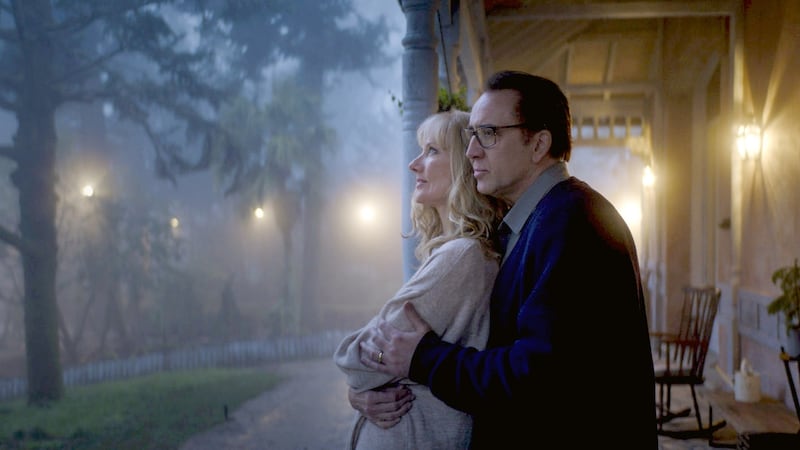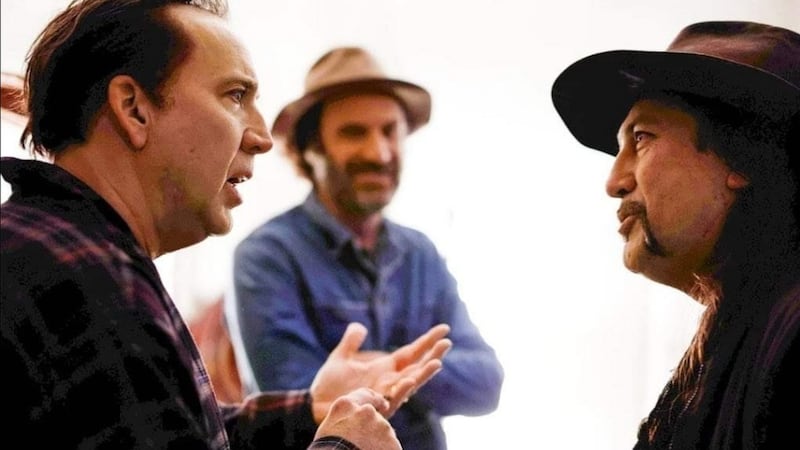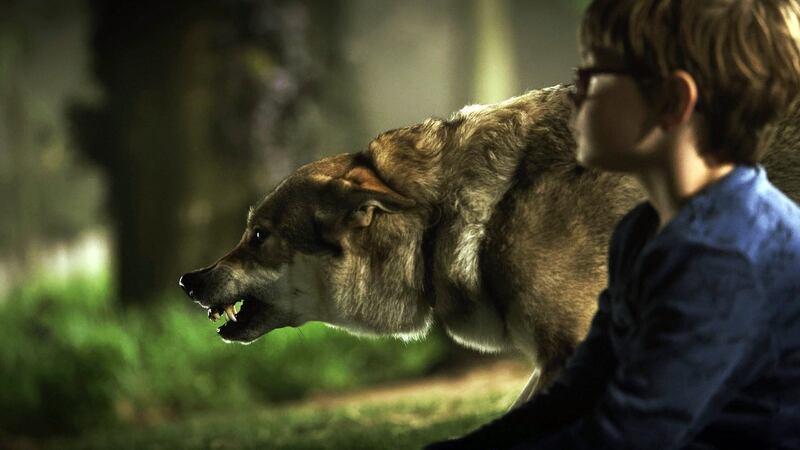Richard Stanley is giving a brief and thrillingly anti-colonial history account of his ancestor Sir Henry Morton Stanley – as in "Dr Livingstone, I presume?" – and it's as entertaining as one might expect from the director of Hardware.
“As a kid, like most kids, I found family history to be pretty boring, and retreated constantly into fantasy,” says the director. “I thought Stanley and Livingstone were awfully stuffy colonial figures. It was only many years later as an adult when I was able to come back to the material and realise just how awful it all was. It’s bizarre because Stanley escaped from a Welsh workhouse, worked as well as a cabin boy towards the United States, initially joined the Confederate army, got captured by the Yankees, joined the union and flew the American flag when he went on the expedition to retrieve Livingstone. He was briefly feted by the Royal Geographic Society, then got into a huge spat over the travel diaries and went over to King Leopold.”
Well, Sir Henry Morton Stanley hasn't got a patch on his descendant. Richard Stanley has rightly become one of the most celebrated characters in cinema. As recounted in the remarkable documentary Lost Soul: The Doomed Journey of Richard Stanley's Island of Dr Moreau, in 1995 Stanley was briefly the director of the multimillion-dollar adaptation of the classic HG Wells novel, starring two of the hottest actors in the business, Marlon Brando and Val Kilmer.
There were problems from the get-go. Brando's daughter had just taken her own life and Kilmer had learned from a TV report that his wife of seven years, Joanne Whalley, was divorcing him. New Line, the panicked producers, sacked Stanley to calm the situation. He responded by returning to the set as an extra, disguised in a hooded cloak and a latex dog mask, a frontline reporter from what would become one of the great movie bombs of the 1990s.

I'm also developing a disturbing reputation for being the go-to guy when you've got allegedly mad superstars
(Did we mention that, on the shoot, Stanley’s personal assistant was bitten by a venomous spider, an adviser became infected by a flesh-eating parasite and that his mother’s house was struck by lightning three times?)
He has subsequently become, as he puts it, the go-to guy for documentaries about notorious flops, including the 2013 account of Alejandro Jodorowsky’s Dune.
"I'm the guy for the doomed project," laughs Stanley. "I'm also developing a disturbing reputation for being the go-to guy when you've got allegedly mad superstars: Val Kilmer, Marlon Brando and now Nicolas Cage. "
‘Striking sparks’
Cage and Stanley have, as the film-maker puts it, "been striking sparks off each other since the '90s." But it has, nonetheless, taken 22 years, for the pair to get a feature up and running. It's been an even longer journey for Stanley and the project. His mother, the anthologist and illustrator Penny Miller, was a huge fan of HP Lovecraft who read the story Color Out of Space to him as a child. It was one of the last things he read to her at the end of her decade-long battle with cancer. For all that personal investment, Stanley's adaptation is a fierce and compelling battleground with the original, problematic material.
Lovecraft was virtually unknown during his lifetime and was almost exclusively published in pulp magazines before he died in poverty in 1937 at the age of 46, but is now regarded as one of the most significant 20th-century authors of supernatural horror fiction.
“I’m a huge fan of Lovecraft’s work; I’m a lifelong fan,” says Stanley. “But basically I disagree with him on pretty much every philosophical and political issue. I’m not an atheist. I’m not a nihilist. I’m not a cynical materialist. I’m not a racist. I’m not a misogynist. So it felt like I needed to challenge him on those themes, and one way of doing that was to imagine putting my own friends and family in harm’s way. What if it was my mother or my children that was being annihilated by a Lovecraftian threat? That raises the stakes and it flies in the face of the way that Lovecraft himself is totally unconcerned with the human condition.”
Lovecraft's work has frequently been described as unfilmable, a challenge that becomes all the more pronounced with Color Out of Space given that it literally concerns an unearthly and indescribable tint. In Stanley's clever translation, co-written with Scarlett Amaris, Nathan Gardner (Nicolas Cage) moves his family to a rural farm where he attempts to grow tomatoes and raise alpacas.
“The alpacas were a dream to work with,” he says. “That was a genuinely good idea. I didn’t want to have cows and pigs and chickens and regular farm animals wandering around. And alpacas don’t kick as hard as ostriches.”
As Color Out of Space opens, Gardner’s wife (Joely Richardson) has recently had a mastectomy, his daughter, Lavinia, takes up Wicca and and his son, Jack, withdraws into astronomical interests. These concerns are swiftly eclipsed by terrifying extra-terrestrial interference. As the titular hue indicates, there are aspects of the source material that are tricky to translate to screen. But as the director notes, there’s no such thing as “unfilmable”, despite how often that word appears in relation to Lovecraft.
"The word unfilmable is like a red rag to a bull for me," says Stanley. "And it's especially lazy when applied to Lovecraft. Because there's a huge amount of material out there and, moreover, it's in the public domain. So anyone can adapt a Lovecraft story or adapt an Edgar Allan Poe story any time they want. And I don't see any reason why they shouldn't. There should be new adaptations of the major stories every generation. There should be more Cthulhus out there. I'm hoping this will open the floodgates."
Infamous disruptions
It’s a commendale plan. But, having experienced the infamous disruptions of Dr Moreau, it took four days for the director to realise that Color Out of Space was actually happening.
“I guess the experience of being removed from Dr Moreau and then a good 20 years of developing other projects which failed to make the transition from page to screen meant that I was extremely sceptical about the film’s chances of getting out of a box,” says Stanley.

When I was four years old, my dad brought home a 16mm print of the original 1933 version of King Kong
"When Nic Cage initially phoned me from a bar somewhere in Nevada, his phone call came through it about four in the morning here in France. I remember thinking: okay, that's pretty far-fetched. But beyond going outside and having a smoke and talking to my cat I didn't think on it any further. I didn't believe that we were moving forward with the film until the producers literally drove up and [started] banging on my door and told me to get in the car. Even then, it wasn't until about four days into production before I stopped walking on eggshells. I had this idea that SpectreVision, the production company, had [Mandy director] Panos Cosmatos locked in a cupboard somewhere waiting to spring out and take over. But then the rushes were consistently excellent."
Richard Stanley, according to the words uttered by the star of his ill-fated Island of Dr Moreau adaptation, should have been a contender. A brilliant, unique filmmaker who scored cult hits with Hardware and Dust Devil against Sisyphean odds, for two decades he has disappeared into Montségur, in the foothills of the Pyrenees, earning a living as “the only English-speaking guide there”.
Stanley was born in Fish Hoek, South Africa in 1966. He grew up in a family defined by visual art, but not necessarily by the moving image.
“My mother and sisters were tremendous artists,” he says. “My mother was a graphic artist and an illustrator. She was immensely talented. I just couldn’t compete with my own work as a draftsman. But when I was four years old, my dad brought home a 16mm print of the original 1933 version of King Kong. That was the first movie I’ve ever seen growing up in Africa where I was mercifully free of television. It had a vast impact. And the character of Carl Denham probably became imprinted on me. The character that was determined to go where no one has ever been before and bring back something no one has ever seen. I thought: wow, that sounds like a good job.”
Afghanistan
After winning the IAC International Student Film Trophy film award in 1984, Stanley travelled to Afghanistan to document the Soviet-Afghan War. He and his crew chronicled the Soviet withdrawal and the country's descent into the civil war that would bring the Taliban to power. Returning from the siege of Jalalabad, he made his feature debut in 1990 with the post-apocalyptic science fiction film Hardware, featuring Iggy Pop, Carl McCoy, GWAR and Lemmy.
“I like to say that Hardware is what I had instead of PTSD,” says Stanley. “I was way too young to even understand that I probably should have had some psychiatric counselling after I came back from Afghanistan. Instead I just went straight from that into shooting. I think that expresses itself with the level of hysteria in the movie.”

Lovecraft succeeded in doing something that almost no one else has been able to get their heads around
The film, in which a soldier gifts a broken cyborg to his artist girlfriend in a dystopian future, only for the robot – called the Mark 13 – to go on a murderous rampage, became a cult sensation. But legal wrangling has prevented a sequel. Indeed, Hardware didn’t get a DVD release until 2009.
“I’ve always been surprised that Hardware managed to claw its way out of the video dustbin and stick around the way it did,” says Stanley. “I’m sorry that we never got to do the sequel. Everybody wanted to bring back Mark 13 but unfortunately the rights have been tied up in such an impenetrable mess between the remains of Palace films and Harvey Weinstein. It’s a shame. Because given the current state of the world I like to get back to apocalyptic dystopian near-future sci-fi.”
Unnerving cinema
His 2002 supernatural horror Dust Devil was a second cult sensation. Stanley sees a direct link between his knack for unnerving cinema and growing up in apartheid-era South Africa.
“I was used to the idea that the government was corrupt and wasn’t going to help you,” he says. “It was the old punk maxim. There was essentially no future. There was no point putting down roots or trying to build for anything. Plus, in South Africa everyone gets two years of military training to learn about weapons and killing people. I made a conscious decision at 16 to desert the South African army and get the hell out of Dodge. I like to imagine that if I had I been growing up in 1930s Germany that I would have had the good sense to do the same. It also makes it very difficult to turn a blind eye when you see the same things happening in other parts of the world.”
Happily, after the best part of a quarter of a century, Stanley – one of the movieverse’s most unique voices – is finally back in action. He’s currently working on the second instalment of a proposed Lovecraft trilogy.
"Lovecraft succeeded in doing something that almost no one else has been able to get their heads around," says the director. "He created this shared universe back in the 1920s. The Cthulhu mythos has become so much part of our culture that kids in Africa or Russia or Japan can identify Cthulhu by the badge I wear on my coat, even when they don't know who I am and despite the fact that Lovecraft himself is not particularly likeable."
Color Out of Space is in cinemas now












